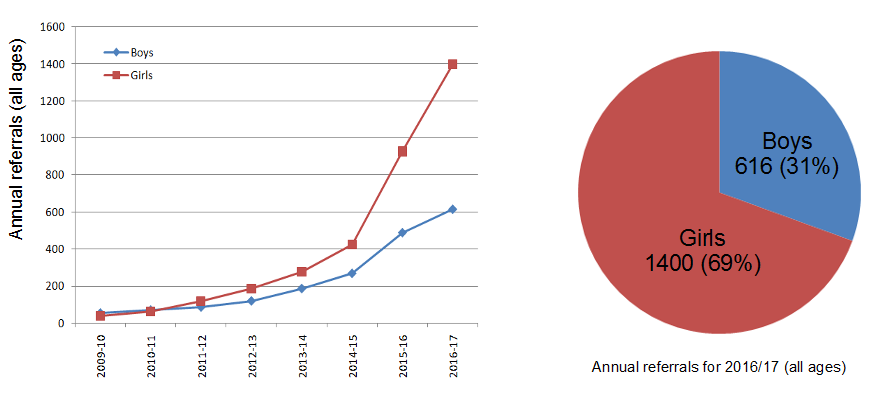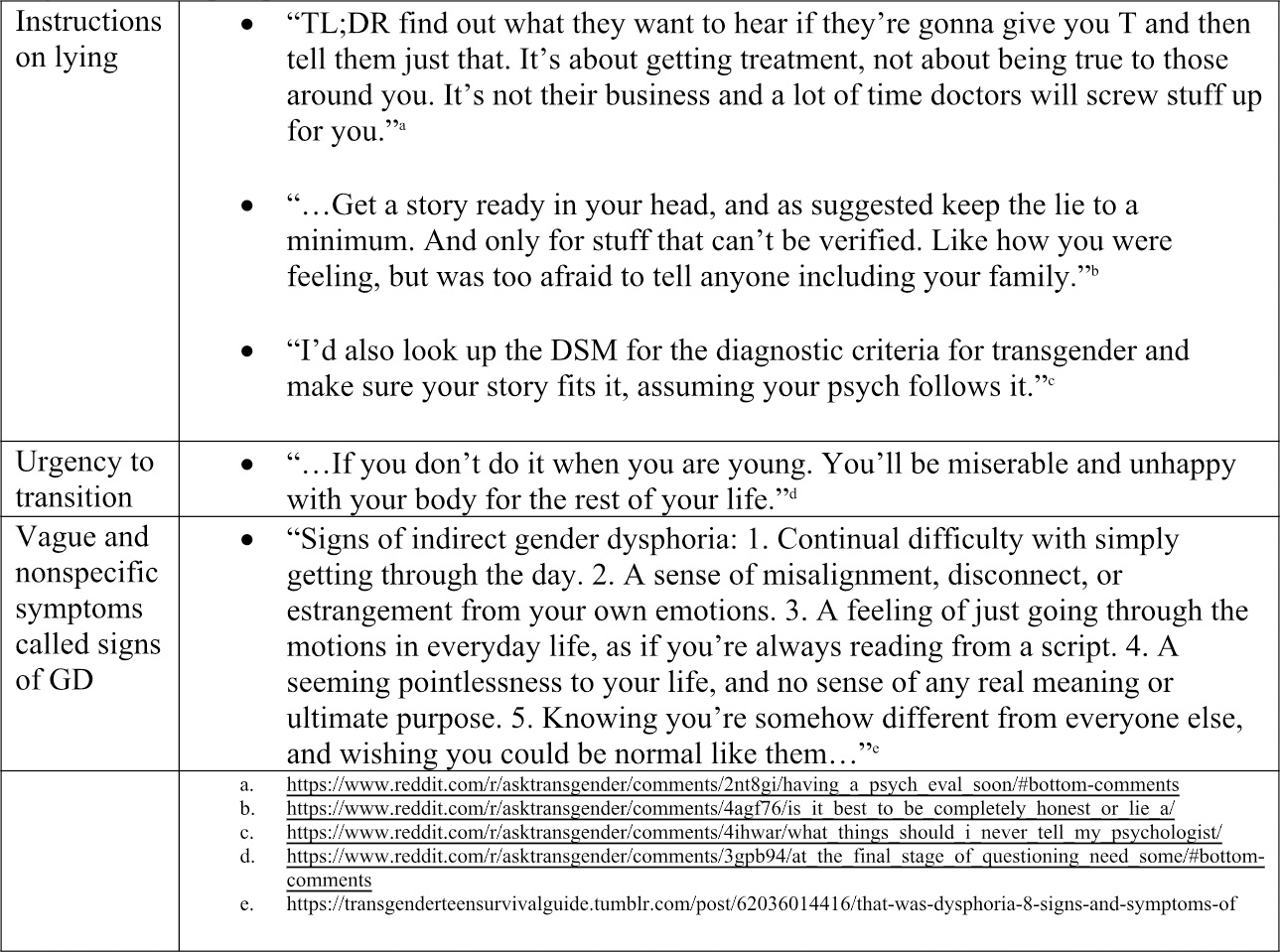“Rapid-onset gender dysphoria” among teens and young adults may be a social contagion linked with having friends who identify as LGBT, an identity politics peer culture, and an increase in internet use, finds a study out this month from a Brown University professor. The study was quickly yanked from Brown’s news releases after a transgender activist feeding frenzy, and the journal it was published in is reconsidering the publication. There is a parent and researcher-driven petition to stand behind the publication of the first study to look in detail at rapid-onset gender dysphoria.
The petition includes the following graph about gender referrals in the United Kingdom. Anecdotal and news reports, as well as the rapid recent growth in transgender treatment centers, indicates a similar phenomenon inside the United States.

“[T]he parental reports in this study offer important and much-needed preliminary information about a cohort of adolescents, mostly girls, who with no prior history of dysphoria, are requesting irreversible medical interventions, including the potential to impair fertility and future sexual function,” says the petition. “In any other group of children, these grave consequences would be seen as human rights violations unless there was significant and overwhelming evidence these procedures would be beneficial long-term.”
Despite these facts on the ground, Brown issued a statement Tuesday effectively apologizing for publicizing their own professor’s research because, “Brown community members express[ed] concerns that the conclusions of the study could be used to discredit efforts to support transgender youth and invalidate the perspectives of members of the transgender community.”
“The spirit of free inquiry and scholarly debate is central to academic excellence,” said the statement from Bess Marcus, the dean of Brown’s School of Public Health. “At the same time, we believe firmly that it is also incumbent on public health researchers to listen to multiple perspectives and to recognize and articulate the limitations of their work.”
Hm, I wonder if she would worry about “invalidating the perspectives of members of the alternative health community” after a Brown researcher published a study indicating a vaccine is effective and anti-vaxxers went crazy about it on Twitter. Doubtful.
The reason trans activists went nuts is that the study reinforces what plenty of parents, public health experts, and doctors have been saying: Transgenderism looks a lot like a dangerous fad. It’s telling that their response was to demand suppressing the results. It’s also telling that Brown chose to prioritize the unreasonable demands of a tiny minority above the potential well-being of children and the process of scientific inquiry.
How This Study Came About
The study is authored by Lisa Littman, a behavior and social sciences professor at Brown, and an OB-GYN whose publications are mainly in reproductive health and abortion. Here’s the phenomenon that caused her to conduct the study to learn more:
Parents have described clusters of gender dysphoria outbreaks occurring in pre-existing friend groups with multiple or even all members of a friend group becoming gender dysphoric and transgender-identified in a pattern that seems statistically unlikely based on previous research. Parents describe a process of immersion in social media, such as ‘binge-watching’ Youtube transition videos and excessive use of Tumblr, immediately preceding their child becoming gender dysphoric. These descriptions are atypical for the presentation of gender dysphoria described in the research literature…
Littman recruited for the study by posting on the transgender-critical websites 4thWaveNow, Transgender Trend, and YouthTransCriticalProfessionals, seeking parents of adolescents who had quickly come out as transgender. She recruited 256 parents of children ages 11 to 27. They filled out a 90-question survey that took about 30-60 minutes to complete. Eighty percent of their transgender-identifying children were female, and on average the kids came out at age 15.
While the author and any social scientist will tell you the study design has many flaws — self selection and self reporting among them — it is comparable in quality to studies that LGBT activists amplify when it serves their narratives. For example, a recent study that found kids of lesbians had outcomes as good or better than that of married biological parents also had self-selected participants who self-reported outcomes. Even though that had only one-quarter the sample size of Littman’s study, it was widely celebrated and published about in prominent outlets.
Littman found a number of things that make transgender narratives look terrible. For example, she explored the horrifyingly irresponsible lies anonymous internet users frequently offer to confused kids who were apparently free to browse for this information online. The below graph from the study quotes common “advice” transgender activists gave children over these kinds of forums.

It is also notable that 86 percent of the parents who took this survey said they support same-sex relationships and 88 percent “believe trans people deserve the same rights and protections as everyone else.” Similar numbers supported their kids’ decision to adopt opposite-sex hairstyles, clothes, and so forth. Of the children who told their parents they wanted to see a gender therapist, 82 percent took them.
In other words, this is a highly open and supportive sample of parents who are largely fine with cross dressing and non-heterosexuality but not on board with chopping off their daughters’ breasts or giving their sons female hormones. It’s really hard to see how they can be fairly faulted for wanting other options and more thought before rushing to mutilate and sterilize their children. Instead of harming transgender people’s best interests, instead this study amplifies the concerns of people who clearly care deeply about gender dysphoric kids.
Here’s What the Study Found
The study offers insights into how gender dysphoria seems to develop among those who declare it suddenly. Among the children studied, 59 percent identified as heterosexual prior to expressing gender dysphoria. This is a disproportionately high percent of non-heterosexual kids (41 percent), although homosexuality and especially lesbian activity is highly fluid and tends to dissipate, especially for teens and females. Eighty-seven percent of the children studied became gender dysphoric after friends did, after increasing their time online, or both.
None of the young people Littman studied would have met the American Psychiatric Association’s criteria for diagnosing childhood gender dysphoria, the study says. However, a very high rate, 62 percent, had been diagnosed with a psychiatric disorder or neurodevelopmental disability before their gender dysphoria began.
Nearly half of these children (48 percent) “experienced a traumatic or stressful event prior to the onset of their gender dysphoria,” the study says, such as parental divorce, a death in the family, a romantic breakup, rape or attempted rape, school bullying, family relocation, or a serious illness. Nearly half (45 percent) had been harming themselves before coming out trans. The parents of most of these children also reported they were bad at handling strong negative emotions.
“The majority of respondents (69.4%) answered that their child had social anxiety during adolescence; 44.3% that their child had difficulty interacting with their peers, and 43.1% that their child had a history of being isolated (not associating with their peers outside of school activities),” says the study. One parent explained that her daughter “had very high expectations that transitioning would solve their problems,” the study says. The parent wrote that the child “discontinued anti- depressant quickly, stopped seeing psychiatrist, began seeing gender therapist, stopped healthy eating. [She] stated ‘none of it’ (minding what she ate and taking her Rx) ‘mattered anymore.’ This was her cure, in her opinion.”
This makes it obvious why transgender activists do not want this information public. It suggests many gender dysphoric young people hit a rough patch in life (or several), have poor or immature coping skills, and got the message from peers, online, or both that transgenderism was a handy, simple explanation for their feelings that also offered instant social acceptance and attention.
High Correlation to Peers Who Promote LGBT Sexuality
The study includes other eye-opening information, such as case studies of several children’s stories. Here are three:
- “A 14-year-old natal female and three of her natal female friends were taking group lessons together with a very popular coach. The coach came out as transgender, and, within one year, all four students announced they were also transgender.”
- “A 21-year-old natal male who had been academically successful at a prestigious university seemed depressed for about six months. Since concluding that he was transgender, he went on to have a marked decline in his social functioning and has become increasingly angry and hostile to his family. He refuses to move out or look for a job. His entire family, including several members who are very supportive of the transgender community, believe that he is ‘suffering from a mental disorder which has nothing to do with gender.'”
- “A 14-year-old natal female and three of her natal female friends are part of a larger friend group that spends much of their time talking about gender and sexuality. The three natal female friends all announced they were trans boys and chose similar masculine names. After spending time with these three friends, the 14-year-old natal female announced that she was also a trans boy.”
The study also describes links between social acceptance and even obsession with alternative sexuality as being a high risk factor for children contracting gender dysphoria:
Parents described intense group dynamics where friend groups praised and supported people who were transgender-identified and ridiculed and maligned non-transgender people. Where popularity status and activities were known, 60.7% of the [children with gender dysphoria in the study] experienced an increased popularity within their friend group when they announced a transgender-identification and 60.0% of the friend groups were known to mock people who were not transgender or LGBTIA (lesbian, gay, bisexual, transgender, intersex, or asexual).
The study also may indicate that school “anti-bullying” programs typically created by LGBT activist organizations such as the Human Rights Campaign may help accelerate children identifying as transgender by pushing peers and authority figures to profusely express their support. It also may suggest that Marxist-style identity politics that brand heterosexuality as oppressive increase gender dysphoria. Perhaps this is one reason a 2013 study found that anti-bullying programs actually increase bullying.
“Great increase in popularity among the student body at large. Being trans is a gold star in the eyes of other teens,” wrote one parent on the study response form. Another wrote, “not so much ‘popularity’ increasing as ‘status’ … also she became untouchable in terms of bullying in school as teachers who ignored homophobic bullying …are now all at pains to be hot on the heels of any trans bullying.”
Children who contracted gender dysphoria in the study were highly likely to have peer groups with a culture of directing animosity towards people who are white, straight, and male. “They are constantly putting down straight, white people for being privileged, dumb and boring,” one study participant wrote. Another wrote: “In general, cis-gendered people are considered evil and unsupportive, regardless of their actual views on the topic. To be heterosexual, comfortable with the gender you were assigned at birth, and non-minority places you in the ‘most evil’ of categories with this group of friends.”
The peer groups of rapid-onset gender dysphoric children also routinely mocked family members and adults, the study found, alienating these distressed children from their most likely sources of help. A handful of study participants who heeded their children’s petition to be removed to a different social environment reported the children were much happier and ceased describing themselves as transgender. One of these children “expressed a strong desire to ‘…get out of the culture that if you are [heterosexual], then you are bad or oppressive or clueless.'”
Social Contagion Is a Well-Documented Human Behavior
“The results of the study support the possibility that social contagion, rather than an innate, immutable sense of incongruence between body and mind, may be at work in some of these cases,” says the open letter petitioning Brown to stand behind Littman’s work.
The petition is the work of 4thWaveNow, a networking and information website for gay-friendly parents and researchers concerned about transgender politics. As mentioned above, Littman recruited parents for her study on the site, which trans activists are ridiculously claiming is a “far-right” “hate” site. 4thWaveNow clearly leans politically liberal and strongly supports non-heterosexuality. These are parents who are righteously concerned about manipulating and mutilating children for the sake of a highly politicized narrative that has little real support beyond its ability to create a business and political industry that profits from despair.
I’m a free market supporter, but I also see that markets function on desire, and not all desires are good. It’s good to desire to mother a child. It’s not good to meet that desire by renting a womb and buying the medical machinery and human parts to make one. It’s good to desire social acceptance and a strong identity. It’s not good to address that desire by pretending to be a male when you are a female, or vice versa. Believing and acting on lies hurts people, often badly.
Rather than blaming the market mechanisms by which people pursue these bad answers to their desires, it’s more appropriate to set boundaries defining what longings are good and not, and what are healthy and morally right ways to satisfy them. Markets cannot do this. This is what a society is for. And because our society is failing in this duty, through things like suppressing the research, discussion, and inquiry that facilitates it, we are allowing people to get fame and profit by lying to vulnerable people and facilitating procedures that very likely do more harm than good.
This is what we call exploitation. It’s an old human story. Social hysterias like the Dutch tulip craze, Salem witch trials, lynchings, buying stock in a mythical America where the streets were paved with gold, and countless other contagions are a persistent feature of human history. Often it is intermixed with buying and selling because where there is desire, there is exchange. People did, and still do, buy and sell human beings. Now we are also buying and selling, mixing and matching human body parts. There ought to be both social and legal limits on things like this, and far better ones than we have now.
Desire drives exchange. Thus it’s big business to create desires for products and services. In so doing, business takes on the social and especially religious function of defining, refining, and directing our desires. The answer is to take that responsibility back for ourselves, and inform our desires, and ensure our children’s desires are formed, with history, research, ethics, religion, and other products of an advanced and successful culture.
The goal should be to minimize harm as much as possible. We do that by thinking before acting, and part of that thinking is talking. Research is also thinking, in a particularly rigorous fashion. This is why trans activists try to suppress talking and thinking. That shows very clearly their true goals are not for bettering human society. It also provides even greater urgency that we refuse to heed their wild, petulant, dangerous demands.











